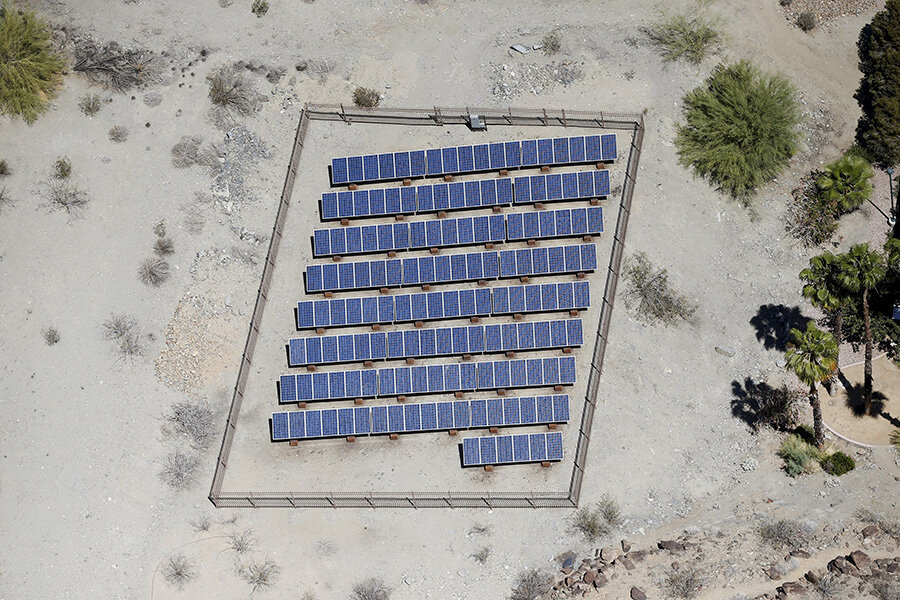Why cheap oil won't stop clean energy
Loading...
Conventional wisdom says cheap oil slows a transition to cleaner fuels. Why switch to solar panels and electric cars when a gallon of gasoline sells for $1.77? Then again, the energy industry of late has been anything but conventional.
By just about every metric imaginable, investors, utilities, and consumers have largely resisted the lure of inexpensive petroleum. Instead, they have poured money, resources, and demand into renewable energy and natural gas.
The result is a US energy system that is decarbonizing at a rate faster than what most experts and analysts expected. It’s good news for the climate, and it’s good news for consumers, too. The one-two punch of energy efficiency and zero-cost renewable “fuels” are keeping utility bills in check, or even bringing them down, according to a report released Thursday by Bloomberg New Energy Finance (BNEF) and the Business Council for Sustainable Energy (BCSE).
Renewables still have a long way to go to match the dominance of fossil fuels, which made modern civilization possible. But, so far, clean energy is passing the litmus test of cheap oil with flying colors. This decade may well be remembered as one in which the clean energy transition reached critical mass.
“2015 clearly marked a turning point for American energy,” Lisa Jacobson, president of BCSE, told reporters in a briefing Thursday. “We have entered a new era here in the United States.”
Last year, the US financed $56 billion in clean energy projects, up 7.5 percent from 2014, according to the BNEF and BCSE report. Renewables accounted for nearly two-thirds of new power capacity installed in 2015, according to new data from the Federal Energy Regulatory Commission. The US Energy Information Administration – an agency that has underestimated renewables growth in the past – estimates that renewable capacity will expand by 9 percent this year.
The usual caveats remain: Wind and solar remain a small fraction of the broader US electricity mix (6.3 percent and 1.2 percent, respectively). There’s still no inexpensive, widespread fix for renewables’ problem of not working when the sun isn’t shining and the wind isn’t blowing. Oil and coal continue to play a major role in the US economy, and are even more important for emerging economies across the globe. But the rapid decline of oil prices – beginning in 2014 and continuing through today – has done more to slow oil producers than it has to attract oil consumers.
Why? There are at least three reasons:
(1) Oil and renewables aren't really in direct competition with one another
Oil and its refined products (think gasoline, diesel, jet fuel, and many others) are typically used to propel cars, ships, and planes. Wind and solar, meanwhile, primarily generate electricity to power and heat homes. So while oil at $30 a barrel may make a car-buyer reconsider that hybrid (which, to some extent, it has), it probably won’t directly influence whether or not that same consumer puts solar panels on his or her roof.
(2) Renewables aren’t the luxury they used to be
Since 1980, solar panel costs have dropped an average 10 percent each year, according to researchers at Oxford University. That trendline is expected to continue. Wind power and battery costs are also falling quickly. As renewables get more cost-competitive with fossil fuels, utilities and consumers are less likely to “backslide” away from new energy sources and toward old ones.
(3) Climate policies are sending a signal to investors and companies
Last December, nearly 200 nations signed on to a sweeping climate agreement that aims to dramatically curb carbon emissions in this century. In the US, states and utilities are preparing to meet new emissions targets set out by the Obama administration’s Clean Power Plan. Across the globe, nearly 40 countries and more than 20 cities, states, and provinces have put some kind of price on carbon to discourage the use of fossil fuels.
These long-term, policy-based levers have a way of softening or canceling out any short-term fluctuations in energy economics. In other words, GM is less likely to scrap its electric vehicle program due to cheap oil if it thinks the long-term trajectory is toward low- and zero-carbon transportation.
Taken together, these trends make for a leaner, cleaner electrical grid. US power sector emissions have dropped to levels not seen since Windows 95 was released. In 2015, emissions were 17.8 percent below 2005 levels, according to BNEF and on their way toward a goal of a 26 to 28 percent reduction from 2005 levels by 2025. Meanwhile, the economy is growing. The US economy grew 10 percent between 2007 and 2015, while overall energy consumption dropped by 2.4 percent.
“The US is getting better at increasing the size of its economy while using less energy to do so,” Colleen Regan, a senior analyst at BNEF, told reporters Thursday.






